*This is a 2023 archived project, view this year’s projects here.
Project overview: Continue monitoring peregrine falcon nests, implement targeted climbing-route closures to protect young falcons, and produce a video about Yosemite’s peregrine success story.
How your support helps: In the mid-20th century, North America’s peregrine falcon populations plummeted toward extinction. Thanks to DDT bans and widespread recovery efforts, the fast-flying raptor has rebounded, including in Yosemite, where peregrines now hunt, soar, and nest on and around the park’s granite cliffs, domes, and spires.
Since that remarkable comeback, the park has been working to safeguard the long-term health of its peregrine population while making sure rock-climbers — who played a direct role in the bird’s recovery by replacing DDT-thinned falcon eggs with healthy, lab-hatched chicks — can continue to access the world-famous walls.
Our donors first funded peregrine recovery work in Yosemite in the 1990s and have since supported many years of falcon-focused surveys and management. The park’s peregrine-focused efforts — honed over decades — balance wildlife management with recreational access to ensure climbers can safely share the cliffs with peregrines. Biologists monitor peregrine nest sites and use their observations to set and lift temporary closures on specific climbing routes.
Through that adaptive, responsive approach, the park can prevent climbers from disturbing peregrine nest sites and give young falcons the best possible chance at survival, while closing no more than 5% of climbing routes at a time. Without support from Conservancy donors for this program, the park would likely have to issue much more widespread, extended climbing-area closures.
Since the park implemented this method in 2009, the number of breeding peregrine pairs in Yosemite has doubled. In 2020 and 2021, the survey team monitored 15 active peregrine nesting sites in the park.
This year: In 2023, your support will allow Yosemite to continue its proven program for monitoring and protecting peregrine falcon nest areas. With your help, wildlife experts will conduct surveys throughout the peregrine breeding season; implement targeted, temporary route closures; and educate climbers about sharing space with peregrines. This year’s work will also include producing a short video about the park’s peregrine success story, which will share the tale of recovering and protecting these iconic raptors with tens of thousands of viewers.
Project partners: Yosemite National Park and James McGrew

